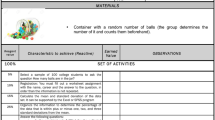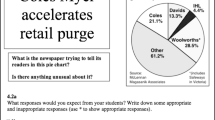Abstract
Many students are under the illusion that the use of IT can accomplish statistical calculations without the need for statistical thinking but the regression models they built are infeasible for making prediction. It is therefore in the present study to assess the operational level of students’ statistical thinking in regression modelling. A sample of students was selected to attempt the seven questions on an individual basis. A qualitative analysis of students’ responses to each of the questions was performed within the assessment framework of Putt et al. as checking which of the four levels of statistical thinking the students had: idiosyncratic thinking, transitional thinking, quantitative thinking and analytical thinking. The analysis results show that most students attained either quantitative thinking or analytical thinking when handling more technical tasks, but not the tasks of reasoning about data; reasoning about results; and reasoning about conclusions. These reasoning tasks demand statistical communication that should be emphasized and monitored throughout Statistics lessons and written works should be assigned to students so that teachers can provide feedback on their writings, as helping them conceptualize material, make links among concepts and internalize thinking.
Access this chapter
Tax calculation will be finalised at checkout
Purchases are for personal use only
Similar content being viewed by others
References
American Society for Quality. (2016). Statistical thinking everywhere. Retreived from http://www.asq.org/index.aspx
American Statistical Association. (2014). Curriculum guidelines for undergraduate programs in statistical science. Retreived from http://www.amstat.org/education/curriculumguidelines.cfm
Biggs, J. B., & Collis, K. F. (1982). Evaluating the quality of learning: The SOLO taxonomy. New York: Academic Press.
Bishop, G., & Talbot, M. (2001). Statistical thinking for novice researchers in biological science. In Proceedings of IASE Round Table Conference on Training Researchers in the Use of Statistics (pp. 215–226). Tokyo: International Association for Statistical Education.
Bude, L. (2006). Assessing students’ understanding of statistics. In Proceedings of the 7th International Conference on Teaching Statistics. Brazil: International Association for Statistical Education. Retreived from http://iase-web.org/documents/papers/icots7/6G3_BUDE.pdf
Campbell, S. K. (2004). Flaws and fallacies in statistical thinking. New Jersey: Prentice Hall.
Chance, B. L. (2002). Component of statistical thinking and implications for instruction and assessment. Journal of Statistics Education, 10(3). Retreived from https://ww2.amstat.org/publications/jse/v10n3/chance.html
Cook, R. D., & Weisberg, S. (1999). Graphs in statistical analysis: Is the medium the message? The American Statistician, 53(1), 29–37.
Curcio, F. R. (1997). Comprehension of mathematical relationships expressed in graphs. Journal for Research in Mathematics Education, 18(3), 382–393.
Gal, I. (1998). Assessing statistical knowledge as it relates to student’s interpretation of data. In S. P. Lajoie (Ed.), Reflections on statistics: Learning, teaching and assessment in grades K-12 (pp. 275–298). New Jersey: Lawrence Erlbaum Associates Publishers.
Hoerl, R., & Snee, R. (2012). Statistical thinking: Improving business performance (2nd ed.). New Jersey: Wiley.
Horton, N. J., & Hardin, J. S. (2015). Teaching the next generation ofstatistics students to think with “data”: Special issue on statistics and the undergraduate curriclum. The American Statistician, 69(4), 259–265.
Jones, G., Thornton, C., Langrall, C., Mooney, E., Perry, B., & Putt, I. (1998). Students’ statistical thinking. In Proceedings of the 19th Annual Meeting of the North America Chapter of the International Group for the Psychology of Mathematics Education (pp. 371–376, 1998). Columbus, OH: ERIC Clearinghouse for Science, Mathematics, and Environmental Education.
Lajoie, S. P., & Romberg, T. A., (1998). Identifying an agenda for statistics instruction and assessment in K-12. In S. P. Lajoie (Ed.) Reflections on statistics: Learning, teaching and assessment in Grades K-12, (pp. xi–xxi). New Jersey: Lawrence Erlbaum Associates Publishers.
Li, K. W., & Goos, M. (2015). A study on students’ attitudes towards teacher’s intervention in statistical computing laboratory. In K. C. Li, T. L. Wong, S. K. S. Cheung, J. Lam, & K. K. Ng (Eds.), Transforming educational practices with technology (pp. 116–126). Heidelberg: Springer.
Putt, I., Perry, B., Jones, G., Thornton, C., Langrall, C. & Mooney, E. (2000). Primary school students’ statistical thinking: A comparison of two Australian states. In Proceedings of the 23th Annual Conference of the Mathematics Education Research Group of Australasia (pp. 519–526). Australia: Mathematics Education Research Group of Australasia.
Taylor, R. T. (1980). The computer in the school: Tutor, tool, tutee. New York: Teachers College Press.
Wainer, H. (2013). Medical illuminations: Using evidence, visualisation and statistical thinking to improve health care (p. 2013). Oxford: Oxford University Press.
Wells, H. G. (1903). Mankind in the making. New York: A Public Domain Book.
Acknowledgements
The author would like to thank Professor S.H. Hou and the anonymous reviewers who gave valuable feedback on an earlier version of the manuscript.
Author information
Authors and Affiliations
Corresponding author
Editor information
Editors and Affiliations
Rights and permissions
Copyright information
© 2017 Springer Nature Singapore Pte Ltd.
About this paper
Cite this paper
Li, K. (2017). Assessment of Student Learning Achievement in Regression Tasks. In: Ma, W., Chan, CK., Tong, Kw., Fung, H., Fong, C. (eds) New Ecology for Education — Communication X Learning. Springer, Singapore. https://doi.org/10.1007/978-981-10-4346-8_7
Download citation
DOI: https://doi.org/10.1007/978-981-10-4346-8_7
Published:
Publisher Name: Springer, Singapore
Print ISBN: 978-981-10-4345-1
Online ISBN: 978-981-10-4346-8
eBook Packages: EducationEducation (R0)




